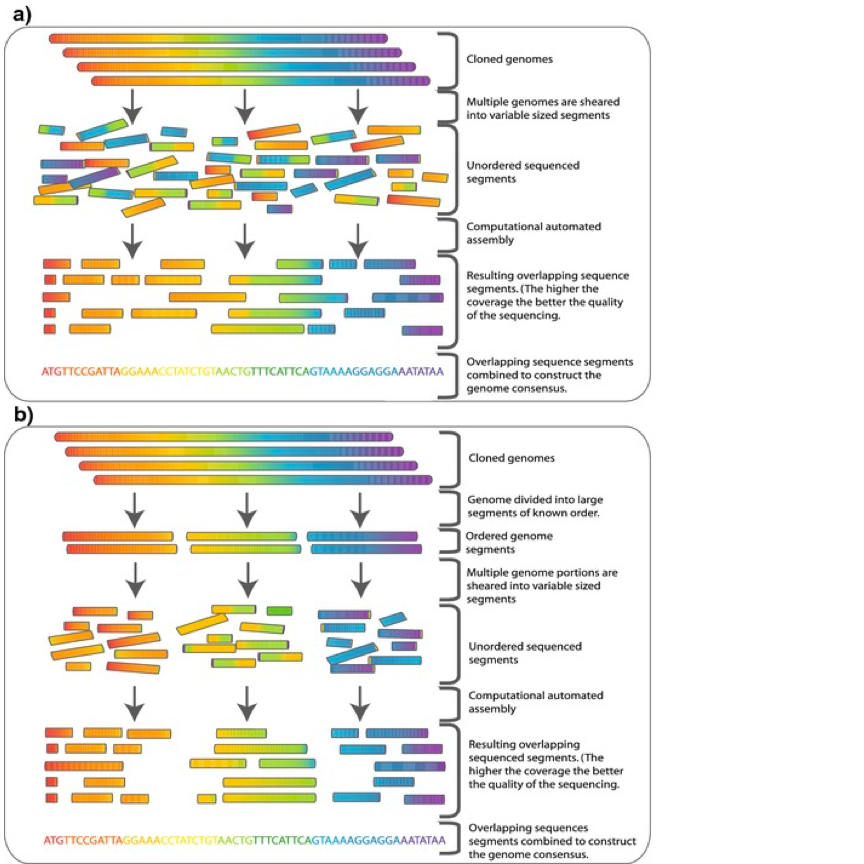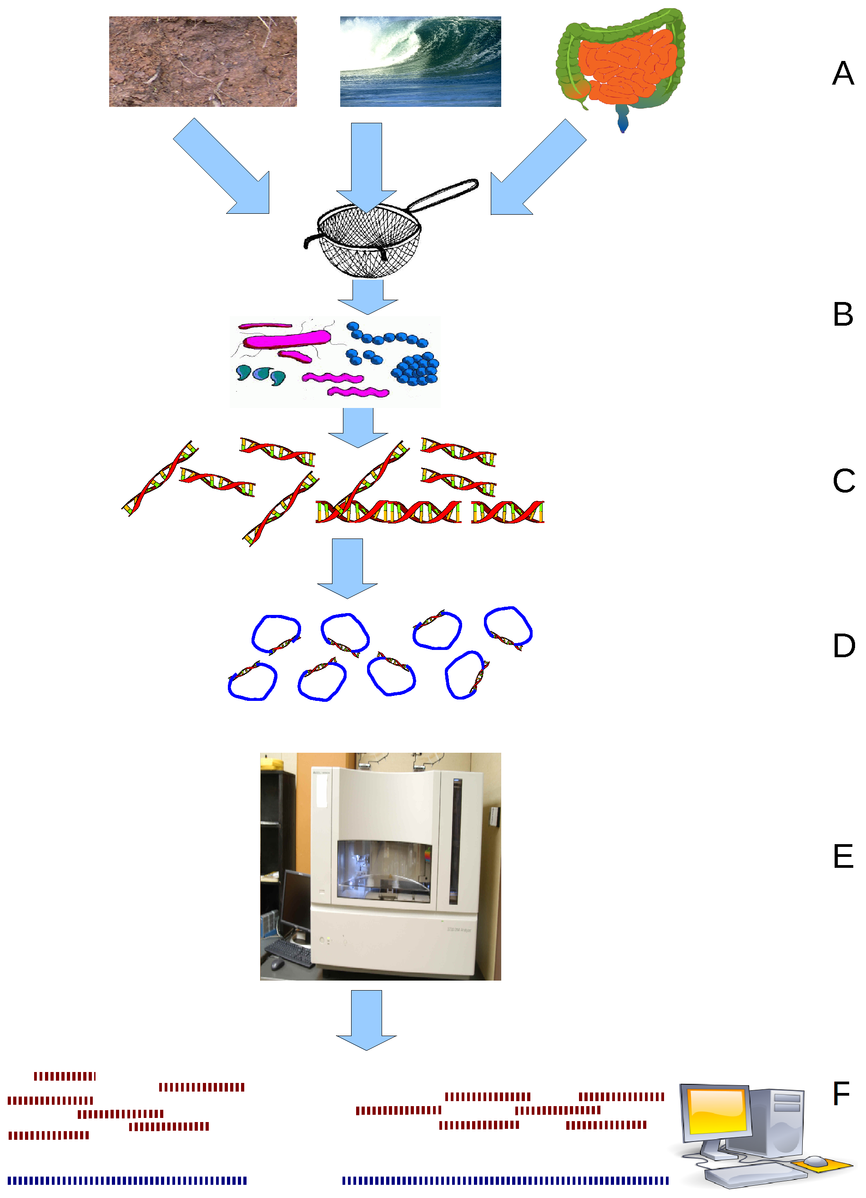Difference Between Whole Genome Sequencing and Shotgun Sequencing
What are whole genome sequencing and shotgun sequencing?
These are methods used for assessing and DNA sequences of an organism’s genome at a single time.
Similarity
Similarities between whole genome sequencing and shotgun sequencing include;
- Both are involved in sequencing Deoxyribonucleic Acid fragments
- Both techniques involve genomic fragmentation
- Both techniques use digitalization and are computer based
- Both techniques play a critical role in research studies and in molecular diagnostics

Whole Genome Sequencing
Whole-genome sequencing aka (WGS) is a detailed technique for investigating the entire genomic Deoxyribonucleic acid sequence of a cell at a single time.
Whole-genome sequencing became available after publishing the Human Genome Project, which provided the reference for human genome sequences.

Shotgun Sequencing
Shotgun sequencing involves unplanned splitting up of Deoxyribonucleic acid breaking up Deoxyribonucleic acid sequences into lots of small fragments and then assembling them again (the sequence) by figuring out the regions of the overlap.
Difference between whole genome sequencing and shotgun
Description
Whole Genome Sequencing
Whole genome sequencing (WGS) is a one-step arrangement process. In this technique, the whole genome (haploid set of chromosomes in a microorganism) shearing takes place first. After this, each of these tiny brittle shards undergoes arrangement process randomly. Once this arrangement or sequencing completes, the analysis takes place. There is elimination of overlapping sequencing process at the time of assessment of the arrangement/sequences, and the assessment is not an ordered technique. Hence, the assembly of sequences is a less successful and efficacious process. However, the process of whole genome sequencing is swifter, and the assessment of the whole genome (haploid set of chromosomes in a microorganism) can take place at a single instance.
Shotgun Sequencing
Shotgun sequencing is a laboratory method for assessing the Deoxyribonucleic acid sequence of an organism’s genetic material (genome). The technique is inclusive of breaking the organism’s genetic material into tiny Deoxyribonucleic acid fragments that represent individual sequencing.
Uses
Whole Genome Sequencing
- New born and pediatric disease – Deducts structural variants and scans exonic areas that are not appropriately captured.
- Drug Trials and Pharmacogenomics – WGS offers beneficial front-end mechanism for clinical trials, that help in classifying individuals (patients) on the basis of their response to the medication or drug under study.
- Regulatory variation and eQTLs
- Rare Rumour Types – WGS is the correct method to investigate rare tumors. The technique helps in studying and capturing the complete range of mutations, from single base changes (a single base in the Deoxyribonucleic acid differs from the usual base at that position) to bigger chromosomal rearrangements, in a one-time experiment.
- Clan Genomics – Family Disease Pedigrees – taps multiplex pedigrees from families impacted by genetic issues.
- Large Cohorts with Extensive Phenotyping
Shotgun Sequencing
- Investigates the Deoxyribonucleic acid sequence of an organism’s genome.
- Efficient method to indirectly sequence Ribonucleic acid or proteins (via their open reading frames)
- The most preferred method for all other kinds of haploid set of chromosomes in a microorganism sequencing also. The total haploid set of chromosomes of many organisms, – the cow, chicken, rat, plant Arabidopsis thaliana, pufferfish, and many microscopic organisms have been sequenced following this technique.
- Near-finished and almost final de novo assemblies of microbial genomes in very less days
- The power to sequence large, complex genomes
- GS FLX+ System read lengths up to 1 kb
- Perform hybrid assemblies
Steps
Whole Genome Sequencing
- Generating sequencing reads directly from a whole -genome (haploid set of chromosomes in a microorganism) repository
- Application of computational methods to reassemble in single step
- Used for fruit fly (Drosophila Melanogaster) and by Celera Genomics (developed 1998) for human genome (haploid set of chromosomes in a microorganism)
Shotgun Sequencing
- Steps in shotgun sequencing include;
- Library preparation
- Sequencing of the cfDNA fragments
- Fragment counting
- Sequence alignment
- Statistical analysis, and reporting.
Summary
The points of difference between whole genome sequencing and shotgun sequencing have been summarized as below:
Whole genome sequencing Vs Shotgun sequencing

- Difference Between Global Warming and Greenhouse Effect - May 18, 2024
- Difference Between Vaccination and Immunization - March 3, 2024
- Difference Between Selective Mutism and Autism - February 25, 2024
Search DifferenceBetween.net :
Leave a Response
References :
[0]Choudhury, A., Ramsay, M., Hazelhurst, S., Aron, S., Bardien, S., Botha, G., ... & Pepper, M. S. (2017). Whole-genome sequencing for an enhanced understanding of genetic variation among South Africans. Nature communications, 8(1), 1-12.
[1]Mardis, E. R. (2008). Next-generation DNA sequencing methods. Annu. Rev. Genomics Hum. Genet., 9, 387-402.
[2]Marie, R., Pedersen, J. N., Bærlocher, L., Koprowska, K., Pødenphant, M., Sabatel, C., ... & Mir, K. U. (2018). Single-molecule DNA-mapping and whole-genome sequencing of individual cells. Proceedings of the National Academy of Sciences, 115(44), 11192-11197.
[3]Venter, J. C., Adams, M. D., Sutton, G. G., Kerlavage, A. R., Smith, H. O., & Hunkapiller, M. (1998). Shotgun sequencing of the human genome.
[4]Image credit: https://commons.wikimedia.org/wiki/File:Environmental_shotgun_sequencing.png
[5]Image credit: https://commons.wikimedia.org/wiki/File:Whole_genome_shotgun_sequencing_versus_Hierarchical_shotgun_sequencing.png
